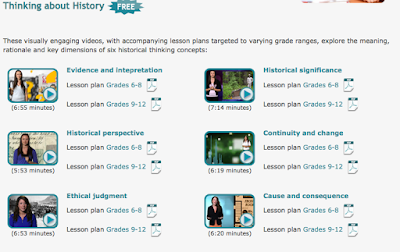Disciplinary Thinking
The Ministry of Education has explained the concepts of thinking for Social Studies, Geography and History.
The intent is that students will"do" the discipline rather than "learn" about it. This focuses students on doing the work of the discipline which includes inquiry based learning.
Click here for a written explanation of the concepts of disciplinary thinking.
Ontario Ministry of Education - Explanation
Watch the Disciplinary Thinking video (specific focus begins at 3:32 in the clip).
The clip may be found on Edugains
The Ministry of Education has explained the concepts of thinking for Social Studies, Geography and History.
The intent is that students will"do" the discipline rather than "learn" about it. This focuses students on doing the work of the discipline which includes inquiry based learning.
Click here for a written explanation of the concepts of disciplinary thinking.
Ontario Ministry of Education - Explanation
Watch the Disciplinary Thinking video (specific focus begins at 3:32 in the clip).
The clip may be found on Edugains
> Click Resources
> Part 5: Social Studies, History and Geography – Overview Pages and Concepts of Disciplinary Thinking
Success Criteria
Visit the resource page to access the success criteria that is related to each of the concepts
(Social Studies, History, Geography). The success criteria sets the target for the use of disciplinary thinking. The success criteria becomes the tool students and teachers can use to assess student performance.
What do the concepts mean to elementary teachers?
The following video is an international clip that explains some of the social studies disciplinary concepts (continuity and change, significance, and cause and consequence).
Our approach in Ontario is being used in several nations.
What does disciplinary thinking look like in the classroom?
Time from Kwan on Vimeo.
Watch this video to gain an understanding of disciplinary thinking and what it means for primary students. (Start at 2:46 to hear about her approach)
Reflection: In this example the teacher speaks about her primary students explaining how they think like historians.
How can you develop the concepts with our students?
Consider how we can use this to develop the concept Continuity and Change.
Understanding Historical Thinking
Middle School teachers can benefit from the following video series that explains the concepts of Historical Thinking
Click here to access the video source. Note that lesson plans are included for grades 6-12.
To learn more about historical thinking visit the Historical Thinking Project.
See the playlist of videos from OESSTA that are linked to disciplinary thinking?
In this example from OESSTA, the teacher shows a systematic way to teach a concept of historical thinking by embedding it in instruction.
Reflection: How can this video be used as a tool to explore continuity and change?
Developing Continuity and Change
> Part 5: Social Studies, History and Geography – Overview Pages and Concepts of Disciplinary Thinking
Success Criteria
Visit the resource page to access the success criteria that is related to each of the concepts
(Social Studies, History, Geography). The success criteria sets the target for the use of disciplinary thinking. The success criteria becomes the tool students and teachers can use to assess student performance.
What do the concepts mean to elementary teachers?
The following video is an international clip that explains some of the social studies disciplinary concepts (continuity and change, significance, and cause and consequence).
Our approach in Ontario is being used in several nations.
What does disciplinary thinking look like in the classroom?
Time from Kwan on Vimeo.
Watch this video to gain an understanding of disciplinary thinking and what it means for primary students. (Start at 2:46 to hear about her approach)
Reflection: In this example the teacher speaks about her primary students explaining how they think like historians.
How can you develop the concepts with our students?
Consider how we can use this to develop the concept Continuity and Change.
Understanding Historical Thinking
Middle School teachers can benefit from the following video series that explains the concepts of Historical Thinking
Click here to access the video source. Note that lesson plans are included for grades 6-12.
To learn more about historical thinking visit the Historical Thinking Project.
How can you teach disciplinary thinking?
Try the following lessons to help students build an understanding of (Geographic) Perspective, (Spatial) Significance, Interrelations and Patterns and Trends. These introductory lessons are useful for grades 1-12. http://bit.ly/2cpLWdr
See the playlist of videos from OESSTA that are linked to disciplinary thinking?
In this example from OESSTA, the teacher shows a systematic way to teach a concept of historical thinking by embedding it in instruction.
Reflection: How can this video be used as a tool to explore continuity and change?
Developing Continuity and Change
Reflection:
How this video can be used to explore the concept of continuity and change.
What aspects can be observed and compared?
 Developing Significance
Developing SignificanceIn this task students determine images that should be represented on Canadian coins based on their investigations.
Reflection: How can significance be addressed in the strands you are teaching?
Developing Perspective:
An examination of the following articles/videos can be used to explore the concept of perspective or geographic perspective:
Natural Resources
The Footprint of the Canadian Lumber Industry Click here
Elizabeth May on the decline of Canada's forests Click here
Keystone Pipeline Click here
Thousands rally to stop XL pipeline Click here
First Nations take their pipeline protest to the top Click here
Historical Perspective
Columbus Controversy Click Here
Christopher Columbus Click here
Why do we need to explore different perspectives?



